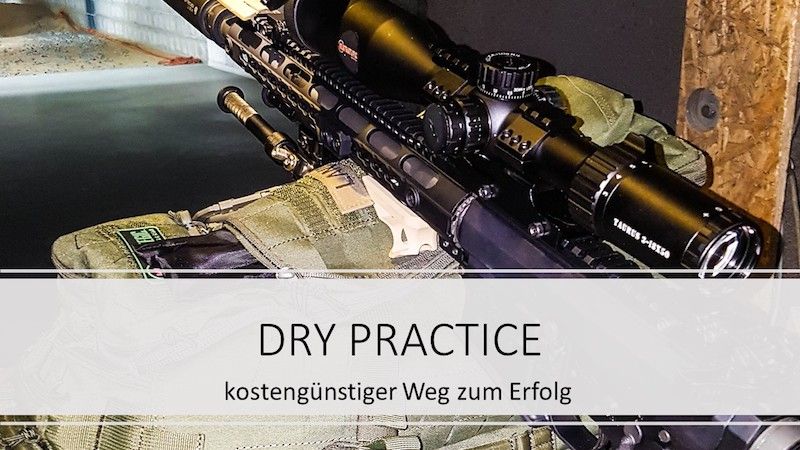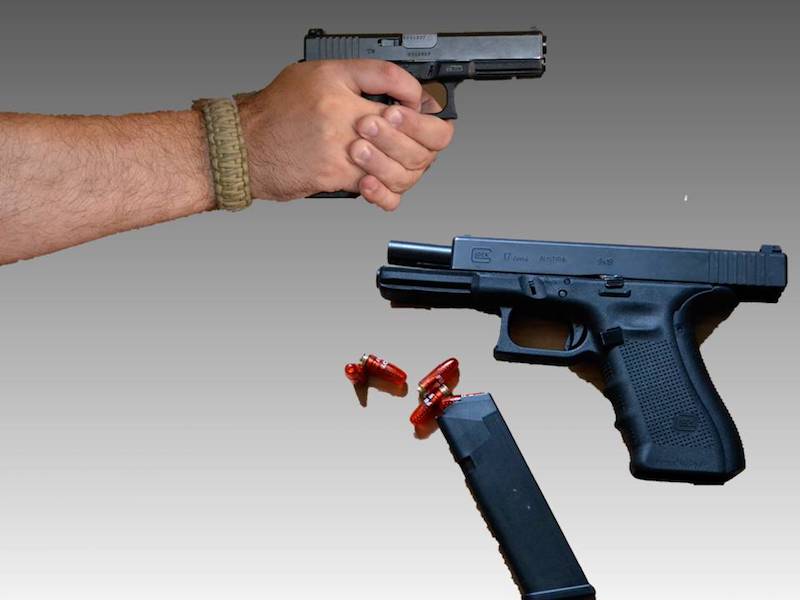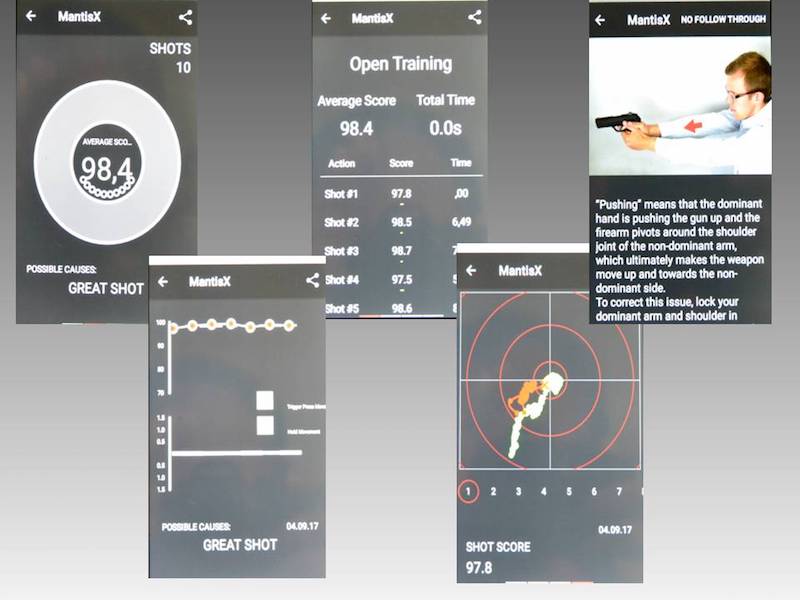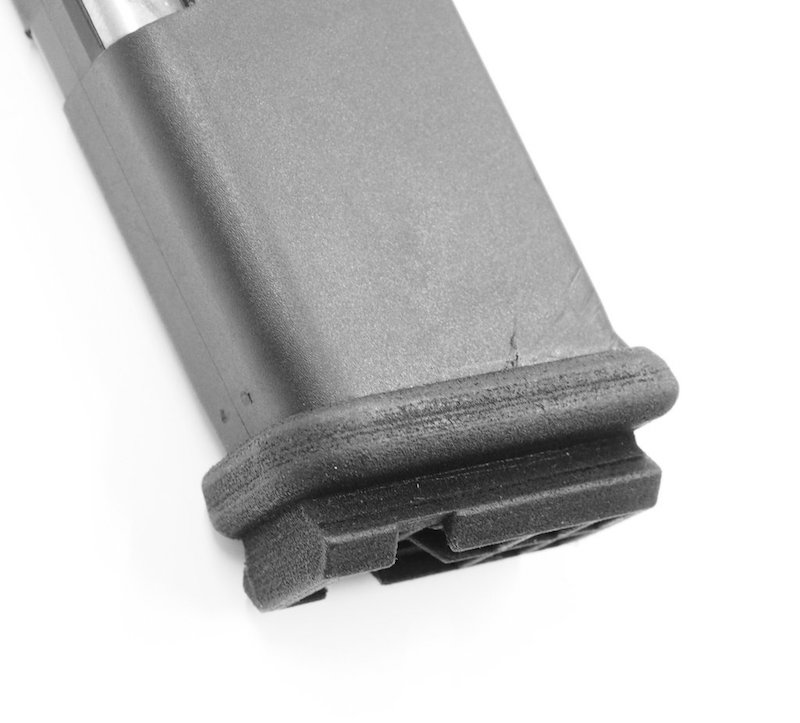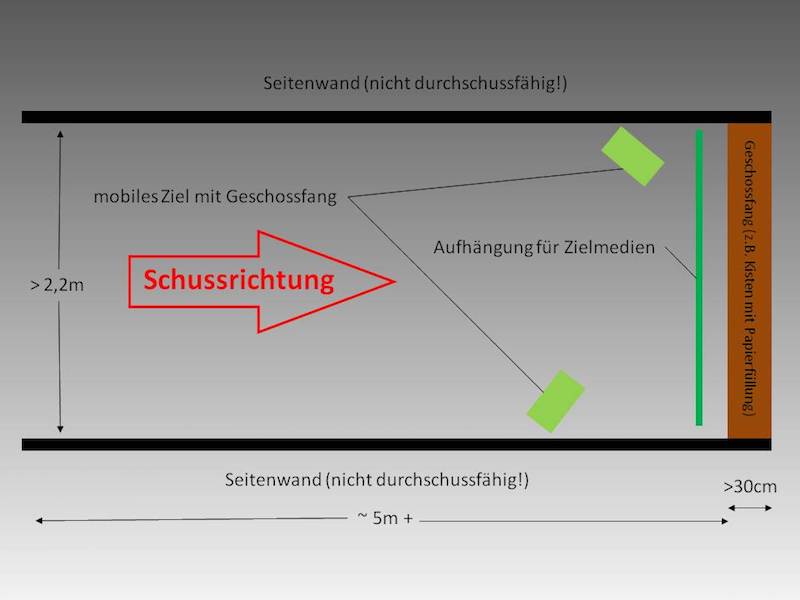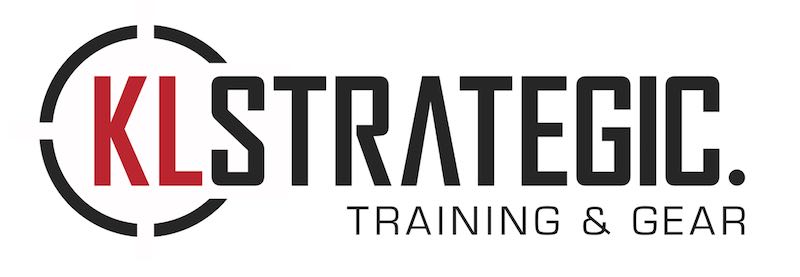Hol Dir den wöchentlichen SPARTANAT-Newsletter.
Dein Bonus: das gratis E-Book von SPARTANAT.

TRAINING MIT KL STRATEGIC (12): HEIMTRAINING
Im letzten Teil dieser Artikelserie möchte ich mich mit den verschiedenen Möglichkeiten des Heim- und Eigentrainings beschäftigen. Für die meisten Schützen und Schützinnen ist das Heimtraining die einzige Möglichkeit, ein kontinuierliches Training durchzuführen.
Im letzten Teil dieser Artikelserie möchte ich mich mit den verschiedenen Möglichkeiten des Heim- und Eigentrainings beschäftigen. Für die meisten Schützen und Schützinnen ist das Heimtraining die einzige Möglichkeit, ein kontinuierliches Training durchzuführen.
Der Besuch des Vereinstrainings ein oder zweimal im Monat mag einigen Gesetzgebern vielleicht ausreichen, um eine genügende Routine im Schusswaffenumgang nachzuweisen. Dies ist bei Weitem nicht genug, um tatsächlich stressresistent Effektivität und Effizienz zu erlernen, zu trainieren und zu erhalten. Oft fehlt Zeit und vielfach auch das Geld, um wöchentlich oder noch häufiger im scharfen Schuss zu trainieren; zudem erlauben viele Vereine und Stände durch eine eingeschränkte Sichtweise ganz einfach nicht, tatsächlich umfassend den Umgang mit einer Schusswaffe zu trainieren. Hier wird leider viel zu häufig noch das Augenmerk auf das reine Betätigen einer Schusswaffe bzw. die Einhaltung von unzweckmäßigen Regularien gelegt, anstatt die gesetzlichen (und auch sportordnungstechnischen) Möglichkeiten auszunutzen. Auch wenn Sportordnungen Disziplinen vorgeben, muss das Training nicht auf diese Disziplinen beschränkt sein. Jede Tätigkeit an einer Waffe ist durch jede Sportordnung abgedeckt und gesetzlich erlaubt. Die einzigen Einschränkungen (in Deutschland) sind das kampfmäßige Schießen und das Verteidigungsschießen für den Zivilbereich.
Nichts desto Trotz werden vielfach Magazinkapazitäten nicht ausgenutzt, Möglichkeiten nicht ergriffen und grundlegende Tätigkeiten schlichtweg unter den Tisch fallen gelassen. Die demographische Entwicklung zeigt aber, dass genau das nicht mehr gewollt ist. Dynamische Disziplinen und umfassende Schusswaffenausbildung erhalten den Zulauf. Das Nachwuchsproblem des traditionellen Schießsports ist selbst provoziert, indem man die offensichtlichen Zeichen der Zeit nicht nur nicht gedeutet, sondern auch nicht verstanden hat.
Aber zurück zum Thema: Für Alle, die ambitioniert dem modernen Schusswaffenumgang frönen möchten, bleiben nur zwei Möglichkeiten:
- Einen eigenen Schießstand haben bzw. fast genauso viel Geld und Zeit investieren, um regelmäßig oft einen Schießstand zu besuchen
- Heimtraining
Da unser Hobby bzw. unsere Passion schon genug Geld verschlingt, müssen die meisten von uns abwägen, wo man das Maximum an Erfolg herausholen kann, ohne unnötig viel Geld zusätzlich investieren zu müssen.
Ein strukturiertes und durchdachtes Heimtraining bietet da eine sehr elegante Lösung. Hat man jedoch nicht die Möglichkeit, so umfassend zu trainieren, bietet jede Minute eines regelmäßigen Heimtrainings mehr Erfolg, als einfach nur am Wochenende mal wieder auf den Stand zu fahren und seine 5 Schuss zu machen. Die eigene(n) Waffe(n) aus dem Tresor zu holen und ein paar Minuten Trockentraining durchzuführen ist schnell realisiert – Keine Fahrzeit, keine Wartezeit und vor allem problemlos auch mehrmals täglich möglich, wenn man es möchte.
Auch der Markt hat dies erkannt und bietet über diverse Anbieter eine Unmenge an Möglichkeiten, um mit Spaß und Freude, aber vor allem effektiv, das Heimtraining durchzuführen.
Warum eigentlich Heimtraining
„Wer aufhört besser zu werden, hört auf gut zu sein!“ – diese grundsätzliche Weisheit hat wohl ewige Gültigkeit. Das, was wir nicht regelmäßig üben verlernen wir, sofern es sich nicht um grundlegende Funktionen des Körpers handelt. Also alles, was wir lernen, können wir auch vergessen. Gerade im Schusswaffenumgang ist der Anteil des Vergessens oft sehr hoch. Um dem entgegen zu wirken gibt uns der Gesetzgeber in Deutschland vor, 18 Mal im Jahr in regelmäßigen Abständen zu trainieren. Dies mag als Nachweis des regelmäßigen Schusswaffenumgangs vielleicht dem Gesetzgeber genügen, doch stellt man auch nur einen minimalen Anspruch bzgl. sicheren Umgang auch in „stressigen“ Situationen ( z.B. Wettkampf), dann stellt man schnell fest, dass es da eines weitaus größeren Aufwandes bedarf, als 18 Termine. Nun hat man die Möglichkeit, jeden Trainingstermin des Vereins, der Einheit, der Dienststelle o.ä. wahrzunehmen, was zu einer deutlichen zeitlichen und finanziellen Belastung führt, oder aber man nutzt Alternativen. Diese Alternativen finden sich im Heimtraining. Hier findet man den Vorteil, jederzeit ungestört, mit eigenen Schwerpunkten unabhängig und so lange man will verschiedenste Aspekte und Abläufe zu üben. Die Möglichkeiten für ein effektives Training kann man mit geringem finanziellen Aufwand schaffen und diese so nutzen, wann und wie immer man es mag. Die mehreren tausend notwendigen Wiederholungen für die Prägung eines Muskelgedächtnisses, die Gewöhnung an eine neue Waffe oder Ausrüstung, die Optimierung von Abläufen usw. sind auf diese Weise kostengünstig und problemlos möglich. Ebenso wie die Neuprägung ist auch der Erhalt der Bewegungsabläufe möglich, sowie die Kombination mit z.B. Übungen zum speziellen Fitnessaufbau/- erhalt. Also nicht nur kostentechnisch, sondern auch biomechanisch kann die Sinnhaftigkeit des Heimtrainings zweifelsfrei belegt werden.
Möglichkeiten des Heimtrainings
Noch vor wenigen Jahren waren die Möglichkeiten für das Heimtraining sehr begrenzt. Dies hat sich inzwischen deutlich geändert. Neue Entwicklungen der diversen Anbieter sowie Innovationen neuer Marktteilnehmer haben den Kampf um den Heimmarkt revolutioniert. Wir als Endverbraucher profitieren davon, nicht nur weil das Angebot deutlich größer geworden ist, sondern auch Systeme, die früher für den privaten Nutzer unerschwinglich waren, mittlerweile zu erschwinglichen Preisen verfügbar sind.
Weiterhin findet man neue Systeme im Taschenformat, die in Leistungsfähigkeit und Leistungsspektrum teurer Anlagen großer Hersteller für den Behördenmarkt in nichts nachstehen, bzw. sie noch übertreffen.
Neben dem klassischen Dryfire Practice – also dem Trockentraining – bietet der Markt verschiedene Systeme zum kontrollierten Training von Einzelaspekten des Schießablaufs, sowie für komplexe Abläufe bis hin zum simulierten Training dynamischer Situationen und Handlungstrainings. Dabei sind all diese Möglichkeiten nicht nur vergleichsweise kostengünstig, sondern bieten auch vielfache Möglichkeiten zur Analyse der eigenen Technik oder des Verhaltens. Die Palette reicht hier von der Eigenanalyse der Mündungsbewegung beim Abkrümmen mit einem Lasereinsatz/ SIRT Waffe bis hin zu automatischen, komplexen Analysen des Abzugsverhaltens, Griff und Anschlag.
Auch die Nutzung von Airsoft oder Co2 Waffen ist längst nicht nur etwas für „Hobbykrieger“, sondern findet immer öfter Einzug auch in professionelles Training und Ausbildung. Ich persönlich bin ein großer Fan dieser Trainingsgeräte, da sie im Handling, Abläufen und Haptik den Originalen ebenbürtig sind.
Es sollte aber beachtet werden, egal welche Form des Heimtrainings man nutzt, dass sowohl die Ehrlichkeit gegenüber sich selbst, als auch die objektive Analyse essentiell sind. Dazu kann entweder eine andere Person gebeten werden, auf bestimmte Aspekte zu achten, oder aber man nutzt die Möglichkeiten der modernen Technik (z.B. Handykamera) um sich selbst beim Training zu filmen und dieses dann auszuwerten.
Betrachten wir uns einige Heimtrainingsoptionen etwas genauer:
Dryfire Practice/ Trockentraining
Das Trockentraining (Dryfire Practice) findet mit den jeweils originalen Waffen ohne Munition statt. Dabei werden Abläufe bis hin zur ersten Schussauslösung durchgeführt. Wer dabei Angst um den „Verschleiß“ seiner Schlagbolzenfeder hat, kann dazu auch Dummypatronen nutzen. Jedoch kann das Ganze auch völlig unbesorgt ohne Dummys absolviert werden, ohne Schäden an der Waffe befürchten zu müssen. Diese Trainingsform ist geeignet für:
- Grifftraining
- Abzugstraining
- Training der Visierausrichtung
- Ablauftraining
- Stand
- Griff
- Ziehen
- Anschlagen
- Abzugskontrolle
- Ladetätigkeiten
- Störungsbeseitigung
Das Trockentraining bietet die Möglichkeit insbesondere Einzelaspekte, als auch Gesamtabläufe quasi kostenneutral zu trainieren. Gerade Feinheiten der Bewegungsabläufe lassen sich hierbei besonders gut beobachten und üben, ohne die störenden Einflüsse des Schusses. Vom Einnehmen und Halten der Körperhaltung/ Schussposition, bis hin zum ersten Schuss kann mit dem Trockentraining grundsätzlich jeder Aspekt geübt und trainiert werden. Aus diesem Grund nutze ich diese Form des Trainings z.B. als Einstieg in meine Kurse, um so nicht nur die Möglichkeiten des Trainings aufzuzeigen, sondern vor allem auch um die gewünschten Abläufe ohne Munitionseinsatz sicher zu vermitteln und üben zu können.
Das schönste an dieser Form des Heimtrainings ist, dass man hierfür nichts weiter benötig, als seine Waffe(n) und ein paar Minuten Zeit. Selbst wenn die Übungszeit „nur“ 5 Minuten beträgt, ist dies immer noch besser, als gar nicht geübt. Somit kann z.B. ein effektives Ablauftraining schnell realisiert werden; Waffenschrank auf, Waffe genommen und losgelegt. Und ganz schnellsind es hier 5 Minuten, da 10 Minuten usw.
Wichtig zu beachten ist, dass man auch bei kurzen Übungsphasen kontenzentriert und kontrolliert übt, bevor man sich kleine Fehler eintrainiert, die auf Unachtsamkeit basieren. Hierbei spreche ich von Eigenkontrolle und Selbstdisziplin, was für ein zielgerichtetes Training selbstverständlich sein sollte.
Laserpatronen/ Laserwaffen
Das Angebot an Laserpatronen und Laserwaffen hat sich in den letzten Jahren deutlich vergrößert. Die klassischen Einstecklaser als Justierlaser wurden weiter entwickelt und für das Training angepasst. So gibt es inzwischen diverse Anbieter (SureStrike, Simway, IMarksman, etc.) die Einstecksysteme mit impulsindizierten Lasern anbieten; das bedeutet, dass der Laser wie ein Schuss durch den Schlagbolzen ausgelöst wird. Als konsequente Entwicklung daraus gibt es die SIRT oder RedGuns. Diese reinen Trainingswaffen lösen durch die „Schussabgabe“ einen Laser aus und entsprechen – je nach Ausführung – den scharfen Originalen in Haptik und Handling. Lange Zeit nur für den Behördenmarkt verfügbar, können die Waffen inzwischen auch zivil erworben werden.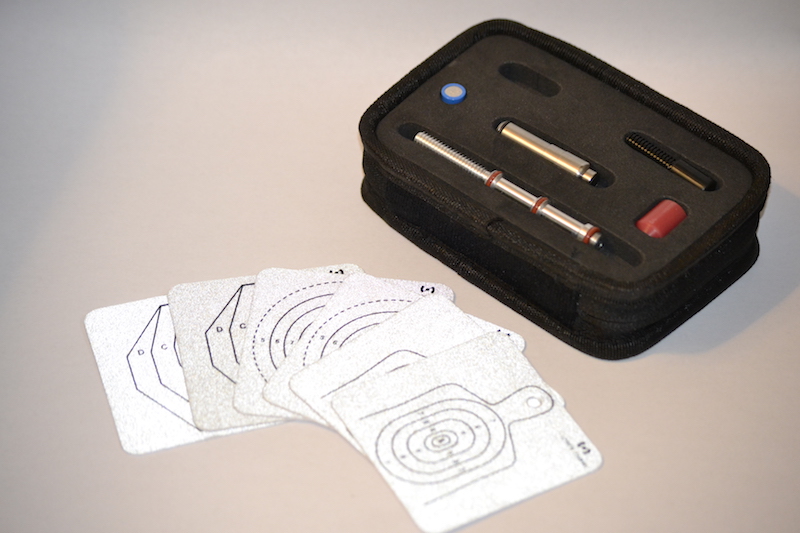
Während die SIRT Waffen von diversen Anbietern vertrieben werden, sind RedGuns i.d.R. von den Waffenherstellern nur direkt zu beziehen.
Welches System man auch immer nutzen möchte, das Trainingsprinzip und die Zielsetzung ähneln sich immer: Erkennen und Auswerten der Mündungsbewegung sowie das schnelle in Ziel gehen. Was früher – und auch heute noch – der Justierung, also dem Ausrichten der Visierung auf den Treffpunkt gedient hat, wird nun dazu genutzt, Bewegungen im Schießablauf erkennbar zu machen und zu analysieren. Der projizierte Laserpunkt ist hierbei als Hilfsmittel sehr gut geeignet. Jedoch sollte man darauf achten, was man kauft. Es gibt günstige Hersteller, deren Lasers in der Einschubhülse nicht korrekt justiert sind. Somit liegt der Laser nicht zentriert im Rohr, was gerade bei Langwaffen dazu führt, dass der Laser nicht parallel zur Rohrseelenachse emittiert wird, sondern gegen die Rohrinnenseite strahlt, was den Strahl abschwächt und reflektiert, so dass im schlimmsten Fall das Licht gar nicht mehr aus dem Rohr austritt.
Laserpatronen mit Impulsgebung finden noch eine weitere Anwendung: Heimschießkinos.
Schießkinos
Denkt man an Schießkinos, kommen einem automatisch diese Millionen teuren Schießanlagen in den Sinn; der Markt bietet jedoch seit einigen Jahren auch Anlagen für das heimische Training an – natürlich nicht im „scharfen Schuss“, wohl aber sogar für Simulationsmunition.
Heimschießkinos basieren i.d.R. auf der Nutzung von Laser/ IR Impulsen. Was vor einigen Jahren noch als teure Spielerei und relativ unausgereift auftrat, hat sich inzwischen zu einem Angebot entwickelt, der für jeden Geldbeutel Möglichkeiten bietet. Von individuell zusammenstellbaren Einzelkomponenten bis hin zu kompletten Gesamtsystemen kann man sich inzwischen in jeder Preisklasse austoben.
Grundsätzlich wird hierfür ein Computer/ Laptop mit entsprechender Software, ein Beamer mit einer Projektionsfläche sowie eine Laserpatrone oder eine lichtimpulsgebende Trainingswaffe benötigt. Je nach Hersteller kann man sich hier ein passendes Paket zusammenstellen oder ein Gesamtpaket nutzen. Hersteller wie z.B IMarksman oder SureStrike bieten sowohl Einzelkomponenten, als auch Komplettpakete an. Letztere findet man in verschiedenen Preisklassen von z.B. Simway mit und ohne Trainingswaffen
So ist schon für wenige hundert Euro ein effektives Heimtraining mit der eigenen Waffe jederzeit umsetzbar.
Hier kann man von einfachen Einzelübungen bis hin zu komplexen dynamischen Situationen alles trainieren, oft inkl. virtuellen Magazinkapazitäten, Einspielung von Störungen und Timerfunktionen. Die Möglichkeit zur Gestaltung eigener Ziele, Übungen, Umgebungen bis hin zu Handlungstranings für behördliche Anwendungen ist eine weitere Ergänzung zur persönlichen Gestaltung des Heimtrainings.
Viele Anbieter ermöglichen inzwischen sogar die Nutzung von Airsoft/CO2 Waffen, die einen Geschossknall und Rückstoß simulieren. Somit kann das Training noch realistischer gestaltet werden. Auch spezielle Heimschießkinos für Luftdruckwaffen jeder Art (z.B. AirCine) sind seit einiger Zeit am Markt ausgereift verfügbar. Möchte man also seine vorhandenen Luftdruckwaffen nutze, anstatt der Lasersimulation, kann man dies mit entsprechenden Systemen auf Geräuschimpulsbasis umsetzen.
Die Nutzung von Lang- und Kurzwaffen auch parallel ist da inzwischen natürlich obligatorisch, ebenso wie die Anzeige und Auswertung der Treffer.
Der Markt bietet im Bereich der Software sogar auf bestimmte Systeme abgestimmte, kostenlose Open Source Software; z.B. ShootOffapp (www.shootoffapp.com) i.v.M. SureStrike Laser Ammo (www.laser-ammo.com).
Diese Schießkinos eigenen sich für sämtliche Arten des Heimtrainings:
- Training von Einzelaspekten des Schießablaufs
- Ablauftraining
- Handlungstraining
- dynamisches Training
- Training diverser Sportdisziplinen bis hin zum Trap/Skeet
- jagdliches Training
- s.w.
Natürlich kann man diese Anlagen auch für die hobbyorientierte Zerstreuung und Freizeitgestaltung nutzen, da Sie i.d.R. auch „Schießspiele“ und Wettbewerbe etc. bieten.
Das besonders Interessante an diesen Systemen ist die Kombinationsmöglichkeit mit anderen Trainingselementen, da hier der „scharfe“ Schusswaffenumgang Eins zu Eins umgesetzt werden kann, abgesehen vom „scharfen Schuss“.
MantisX
Das MantisX firearms training system ist z.Zt weltweit einzigartig. Dieses System analysiert, auf Grundlage von Daten eines, an der Waffe angebrachten, Lagesensor. Das Verhalten der Schützin/ des Schützen vor, während und nach der Schussabgabe, bewertet diese und gibt verschiedene Daten als aufgearbeitetes Analyseergebnis in Echtzeit in der kostenlosen App aus.
Diese Art der Schussanalyse gab es bisher nur für den Behördenmarkt zu einem entsprechenden Preis und Platzbedarf.
Seit gut 2 Jahren ist dieses System nun auf dem Markt und wird von den Herstellern regelmäßig weiter entwickelt und erweitert.
Dieses System aus Sensor und App analysiert auch kleinste Bewegung der Waffe vor während und nach der Schussabgabe. Diese werden verwertet und als prozentuale Bewertung des Schusses, sowie als graphische Darstellungen von Mündungsbewegung, Bewegungsintensität während der Abzugsbewegung und beim Nachhalten ausgegeben. Eine Timerfunktion mit Zeitanalyse der einzelnen Schüsse ist ein weiteres Feature dieser App.
Die größte und wichtigste Funktion ist jedoch die Auswertung der analysierten Daten und den daraus resultierenden Schießfehlern mit Korrekturvorschlägen.
Hierbei werden die ermittelten Bewegungsdaten und Kombinationen den typischen Schießfehlern zugeordnet und daraus Korrekturvorschläge ausgegeben. Erstaunlich daran ist, wie genau die Analyse stattfindet und daraus die korrekten Fehler erkannt und Korrekturvorschläge gegeben werden. In einem Test mit verschiedenen unabhängigen Schießausbildern wurde das System mit bewusst gemachten Schießfehlern herausgefordert und gab IMMER die korrekte Analyse an.
Das MantisX System ist im Heimtraining geeignet für
- Grifftraining
- Abzugstraining
- Zieltraining
- Konzentrationsübungen
- Dryfire Practice
- Airsoft/ CO2 Training
Darüber hinaus funktioniert das System ebenso gut und genau im scharfen Schuss. Die Montage muss dabei nicht zwingend an der Waffe selber erfolgen, sondern kann – für Kurzwaffen – auch an speziellen Magazinböden mit Adapter genutzt werden.
Schießstand
Wer auf den Gang zum Schießstand nicht verzichten möchte und entsprechenden Platz zur Verfügung hat, kann dies auch zu Hause umsetzen. Dabei spreche ich nicht von einem Stand für den „scharfen Schuss“. Dies würde das Budget der meisten Leser deutlich sprengen. Es geht um einem kostengünstigen, aber nicht weniger nützlichen, Luftdruckschießstand.
Das Angebot an realistischen Luftdruck, CO2 und Airsoft Waffen ermöglicht es inzwischen, ohne Funktionseinschränkungen oder Kompromisse im Handling zu trainieren. Was vor wenigen Jahren noch als „hochgezüchtete Erbsenpistole“ begann, hat sich inzwischen zu ernst zu nehmenden Geräten entwickelt, welche einer immer größeren Beliebtheit im professionellen Trainingsbereich erfreuen.
Baut man sich einen eigenen Schießstand, sind unbedingt folgende Dinge zu beachten:
- Es muss sichergestellt sein, dass kein Geschoss das Grundstück verlassen kann
- Nachbarn und Passanten dürfen nicht gestört oder belästigt werden
- Schäden an Mieteigentum müssen verhindert werden
Da die Geschossenergie der angesprochenen Trainingsgeräte nicht der scharfer Waffen entspricht, sind die effektiven Reichweiten begrenzt. Jedoch gibt es kaum etwas, was nicht, entsprechend skaliert, auch im Nahbereich trainiert werden kann. Insbesondere Handling und Abläufe lassen sich hiermit besonders gut trainieren und üben, inklusive Erst- und Folgeschüssen sowohl statisch, als auch dynamisch. Die Möglichkeit einer tatsächlichen Geschossabgabe mit auswertbaren Treffern in einem Zielmedium, sowie ein entsprechend reduziertes, ballistisches Verhalten sind weitere Vorteile dieser Trainingsgeräte.
Auch die Nutzung weiterer, bereits angesprochener, Trainingselemente und -systeme ist hier möglich. Geschossknall und Rückstoß entsprechen zwar nicht genau den Originalen, reichen jedoch aus, um z.B. von Schießtimern und Timerapps erkannt zu werden und Lasersysteme o.ä. auszulösen.
Beim Aufbau eines Heimschießstandes sollte man folgenden Aufbau beachten:
Fazit
Heimtraining ist für jede Schützin/jeden Schützen mit einem gewissen Anspruch an sich selbst zwingende Notwendigkeit. Egal ob Berufswaffenträger, Sportschütze oder interessierter Waffennutzer, das stete Training ist unerlässlich. Die Möglichkeiten sind sehr vielfältig, ebenso wie die Angebote am Markt. Man sollte sich vorher Gedanken machen, welches Ziel man verfolgt und was man bereit ist dafür an Zeit und Geld zu investieren.
Fakt ist: Schießen lernt man nur durch Schießen.
Hat man für sich die richtigen Möglichkeiten für das Heimtraining gefunden ist damit nur die Hälfte geschafft. Teilnehmer meiner Kurse kennen das sog. Leistungsdreieck aus Fertigkeiten, Fitness und mindset und haben erfahren, wie man damit arbeitet, um darauf basierend das eigene Training effektiv zu gestalten; knapp zusammengefasst muss man vor dem Training sich selbst gegenüber ehrlich analysieren, was – entsprechend der eigenen aktuellen Verfassung und den Trainingsdefiziten – sinnvoll ist zu trainieren. Nicht immer ist es auch zweckmäßig an einem Defizit zu arbeiten, wenn die eigenen Verfassung dem entgegen steht. Das sollte man beachten, wenn man sich für das Heimtraining entscheidet. Manchmal reicht es auch aus, einfach 5 oder 10 Minuten die neue Waffe in die Hand zu nehmen und sich mit dem Griff, Abzug, etc. vertraut zu machen; es muss nicht immer die Stundenlange Trainingssession sein.
Im Heimtraining geht es vor allem darum, sich selbst gegenüber ehrlich zu sein, Stärken und Schwächen zu analysieren und entsprechend zu trainieren. Der wichtigste Aspekt ist aber, dass es Spaß macht.
Damit bin ich am Ende dieser Artikelserie angekommen.
Ich möchte mich bei allen Lesern bedanken. Zudem bedanke ich mich bei SPARTANAT für die Veröffentlichung.
Ich hoffe, ich konnte einen Einblick in das stressresistente Schusswaffenhandlich geben und vielleicht den einen oder anderen Anreiz geben, über gewisse Aspekte einmal nachzudenken bzw. das Ein oder Andere kritisch zu hinterfragen.
Das dargestellte Wissen und die Erkenntnisse basieren auf der realen Anwendung und sind nicht in einem Labor oder dem „klinisch reinen“ Schießstand entstanden. Mein Ziel war es, dass man als interessierter Leser von realen Erfahrung in der Anwendung profitieren kann – etwas, was leider viel zu selten genutzt wird. Allgemein stellt man fest, dass die „Endnutzer“, also Schützinnen und Schützen jeder Art eher zu realistischen Handlings tendieren, anstatt den etablierten, abstrakten Konstrukten folgen zu müssen, welche als völlig unnatürlich und pervertiert erfahren werden.
Auch wenn natürlich der klassische Schießsport als Spitzensport seine Berechtigung hat, ist er das eigentliche Problem und die eigene Ursache für eine krankende Zukunftsorientierung. Kaum jemand will mehr auf 25 m statisch stehen und auf eine Ringscheibe schießen, während ihr/ihm dauernd eingetrichtert wird, dass es keinen Spaß machen darf und mit übertriebenem Sicherheitsdenken immer mehr Angst vor der Waffe gemacht wird.
Wenn ich es geschafft habe, dass man sich als Waffenbesitzer/in ein wenig sicherer und komfortabler im Umgang fühlt und eine Waffe – egal welcher Art – nicht mehr als „Fremdkörper“ sieht, sondern als das, was es ist, ein Gegenstand, der zwar ein gewisses Gefahrenpotential in sich birgt, aber auch ein mindestens genau so großes Spektrum an Möglichkeiten, hat sich die Arbeit an dieser Serie bereits gelohnt.
Wenn darüber hinaus noch das Interesse am Grundverständnis für den stressresistenten Umgang geweckt wurde, dann ist das umso besser. Wenn man endlich damit aufhört, Waffen als reine Gefahr zu behandeln und zulässt, von denen zu lernen, die den realistischen Umgang beherrschen, dann ist ein großer Schritt getan. Die Zahl der Anbiete, die diesen realistischen Umgang vermitteln ist überschaubar, steigt aber immer weiter an. Auch die gesetzlichen Möglichkeiten geben sehr viel her, auch wenn viele in Ihrem traditionellen Denken dies nicht hören wollen. Leider gibt es auch in diesem Bereich – wie überall – „schwarze Schafe“.
Am Ende möchte ich nur eines: Dass wir Spaß am Schusswaffenumgang haben, wenn er dem Hobby dient und dass wir uns auf unsere Fertigkeiten verlassen können, wenn es darauf ankommt. All diejenigen, die sich für uns alle in die Schusslinie begeben, egal ob im täglichen Streifendienst, im breiten Bereich der Schutzaufgaben oder aktiv im Auslandseinsatz möchte ich an dieser Stelle danken und hoffe, dass Ihr euch im Ernstfall auf euch und auf die Frau/ den Mann neben euch verlassen könnt.
In diesem Sinne bedanke ich mich bei allen, die diese Serie möglich gemacht haben und würde mich freuen, wenn profitieren konntet und beim nächsten Training die eine oder andere unbequeme Frage stellt.
Khi Pa
Teil1: Alles im Griff
Teil2: Der Anschlag
Teil3: Der natürliche Haltepunkt
Teil4: Die Augendominanz
Teil5: Die Abzugsarbeit
Teil6: Der Arbeitsbereich
Teil7.1: Zielen, die Gretchenfrage
Teil7.2: Zielen, alles auf den Punkt gebracht
Teil7.3: Was Tun Mit Zielfernrohren
Teil8: Sichere Ladetechniken für Pistolen und Revolver
Teil9: Sichere Ladetätigkeiten für Flinten
Teil10: Sichere Ladetätigkeit mit der Selbstladebüchse
Teil11: Alles über Ausrüstung
Teil12: Heimtraining
KL STRATEGIC im INTERNET: kl-strategic.com
KL STRATEGIC auf FACEBOOK: www.facebook.com/KL-STRATEGIC
SPARTANAT ist das Online-Magazin für Military News, Tactical Life, Gear & Reviews.
Schickt uns eure News: [email protected]
Werbung
Hol Dir den wöchentlichen SPARTANAT-Newsletter.
Dein Bonus: das gratis E-Book von SPARTANAT.

